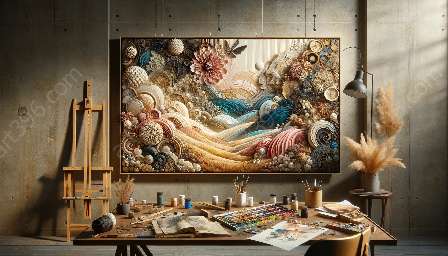Understanding and exploring spatiality within the context of environmental elements is a significant aspect of contemporary mixed media art. This creative expression involves the use of diverse materials, techniques, and sensations to create an immersive experience for the audience. It reflects the complex interactions and interconnections between spaces and the environment, inviting viewers to engage with multifaceted dimensions.
Key Elements in Spatiality and Environment
Mixed media art, which encompasses a broad spectrum of mediums and forms, offers a dynamic platform for artists to investigate spatiality and environment. It allows for the utilization of various materials such as found objects, textiles, photography, and digital elements to construct multi-layered compositions that convey unique narratives. The interplay between physical and virtual spaces within mixed media artworks creates an evocative environment, blurring the boundaries between the tangible and intangible.
- Physical Spaces: Artists often utilize three-dimensional elements to convey spatial depth and engagement, drawing the audience into the artwork's physical presence. Through the incorporation of sculptural components, installations, or assemblages, they challenge the traditional concept of flat, two-dimensional surfaces and transform the viewing experience into an exploration of space and volume.
- Environmental Considerations: The inclusion of environmental themes and concerns adds a profound layer of meaning to mixed media art. Artists may incorporate natural, organic materials or address ecological issues to raise awareness and provoke contemplation about the complex relationship between humanity and the environment. This approach further enhances the spatial and environmental dialogue within the art form.
Immersive Experiences and Spatial Narratives
Contemporary mixed media art transcends conventional boundaries to create immersive experiences that resonate with the viewer on multiple sensory levels. Through innovative techniques and multimedia integration, artists construct intricate spatial narratives that unfold as viewers engage with the artwork.
By skillfully blending textures, colors, and forms, artists construct not only visual landscapes but also emotional and psychological environments. They invite viewers to navigate through the created spaces, fostering a sense of personal connection and exploration.
Technology and Mixed Media
The advent of technology has expanded the horizons of mixed media art, enabling artists to incorporate digital elements and interactive components into their spatial and environmental representations. Virtual reality, projection mapping, and interactive installations offer new dimensions to explore the relationship between art, space, and environment.
Conclusion
In conclusion, spatiality and environment in mixed media art offer a captivating journey into the convergence of physical, conceptual, and environmental elements. Through a diverse range of mediums and techniques, artists craft dynamic representations that stimulate the senses and provoke contemplation. This intersection of spatiality and environment in contemporary mixed media art transcends traditional boundaries, creating an immersive and thought-provoking experience for both creators and viewers.

